A 7-Step Guide to Making SEO Content Writing a Habit

Table of contents
- What is SEO?
- How do You Start with SEO?
- What is SEO Content Writing?
- 7 Step Guide to Writing SEO-friendly Content
- Key Takeaways
- Conclusion
- FAQs
According to Orbit Media Studios, over 7.5 million blogs are published each day. That means over 300K blogs are posted every second.
Over the years, the internet has become more accessible. Further, the global pandemic has boosted the accessibility and use of the internet for everyday tasks, as people, schools, and businesses have come online. The numbers are set to increase in the next quarter.
This means writing a blog and making it more user-friendly is more important than ever for businesses, and getting it listed on search engines is the ultimate goal. SEO content writing is the answer to it all.
Based on a stat published by Internet Live Stats, Google processes over 3.5 billion searches per day, meaning 40,000 queries per second.
Hence, writing a blog is just not enough. Businesses have to make sure the blogs are completely optimized and follow all the guidelines Google mentions. Writing SEO content makes it more search-friendly and readable. To write SEO content, you must focus on keyword optimization and making your website more navigable. The two most important SEO content writing tips are to make your content relevant and search-engine friendly. SEO has ruled the blog world ever since Google’s Blog Network began.
What is SEO?
SEO content writing is the process of getting a website or blog ranking high on search engines with zero advertising. It is a process of optimizing the content and organizing it high on the search section of search engines like Google so that people can easily view and land on your website/business.

To understand it better, consider an example:
When you search on Google, you are the ‘searcher,’ Google is the ‘search engine,’ and the website you land on is the ‘business.’
When you search for ‘Coronavirus symptoms,’ you will see the top optimized content on the first page of Google.
So, how does a business list their blog on Google (focusing on Google because it is the platform that 90% of people use globally, as per review42)?
Well, SEO is the answer.
Search Engine Optimization is the most important factor in listing your blogs on Google.
We will list a 7-step guide to making SEO content writing for beginners a habit that will help your blog climb the search engine ranking and improve your business listing.

How do You Start with SEO?
- To write SEO content, start with research on your blog topic and competitor analysis.
- Develop a structure for the blog and keywords you will be focussing on.
- Focus on on-site SEO.
- Build backlinks.
- Regularly update the blog content.
- Analyze your blog and website regularly.
Google’s #1 priority has been and will be the user experience. It is the experience your web page provides to users when someone searches on Google. Google displays web pages based on the relevance and authority of the page.
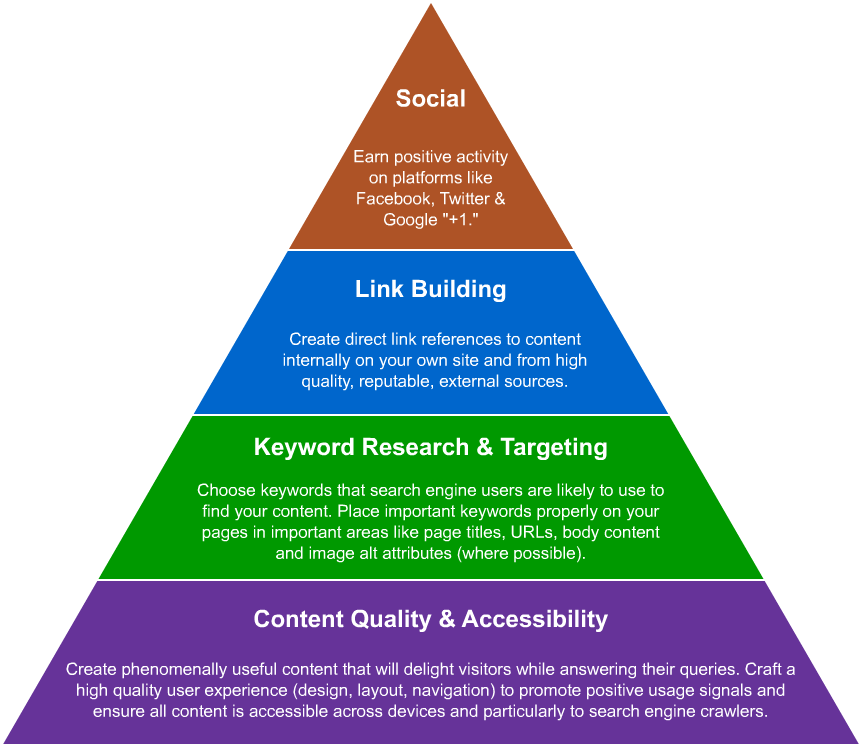
Several factors determine your website’s relevance and authority which includes:
- Usage of relevant keywords.
- The number of backlinks.
- Readability of the content.
According to Google Panda, the quality of backlinks has become the top priority of Google to rank any web page on its search engine.
What is SEO Content Writing?
Good SEO content is easily crawlable by Google and relevant for its readers. The content needs to have relevant keywords that a search engine user is looking for, allowing a person to take some action. This action can be subscribing to your newsletter, buying your product, or asking for more information.
This guide will help understand all the critical steps required to generate qualified traffic to your website over some time.
Also, SEO is changing every day and sometimes can be very difficult to understand if you are a beginner. Using this 7-step guide, you’ll write the best SEO content and make the best out of your business.
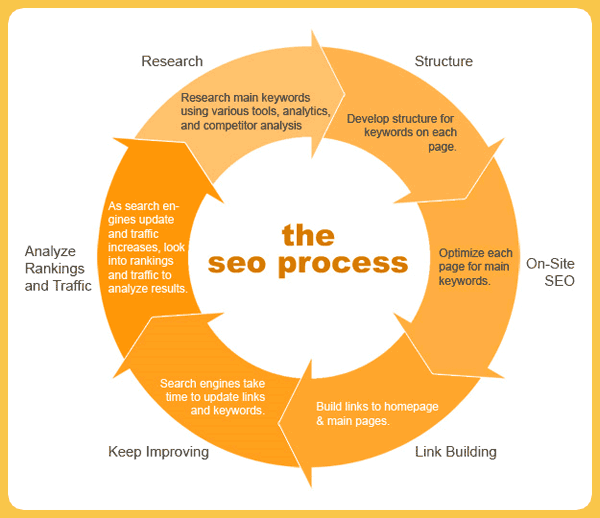
Moz’s founder, Rand Fishkin, lists the following things necessary when creating SEO-friendly content.
- Crawlability means allowing Google to crawl on your website.
- Using the right keywords that answer the searcher’s query.
- Keyword optimization.
- The website’s user interface and user experience (UI/UX), including site speed.
- Sharable content that allows users to share content across platforms.
- Having heading, description, title, and right URL for click-through rate (CTR).
- Schema markup for search engine results page (SERPs).
7 Step Guide to Writing SEO-Friendly Content
Let us now take a look at a step by step guide on SEO based content writing:
1. Getting your SEO basics right and why it matters?
Understand your target audience and write for them. This is one of the most important SEO content writing tips. As an SEO content writer or digital marketer, you should understand what your end-customer will be searching on Google, what type of content they are looking for, and addressing their problems.
A search engine is nothing but a type of answering machine. The job of an answering machine is to curate the best content for its users. The process of curating the content is called ‘crawlability.’
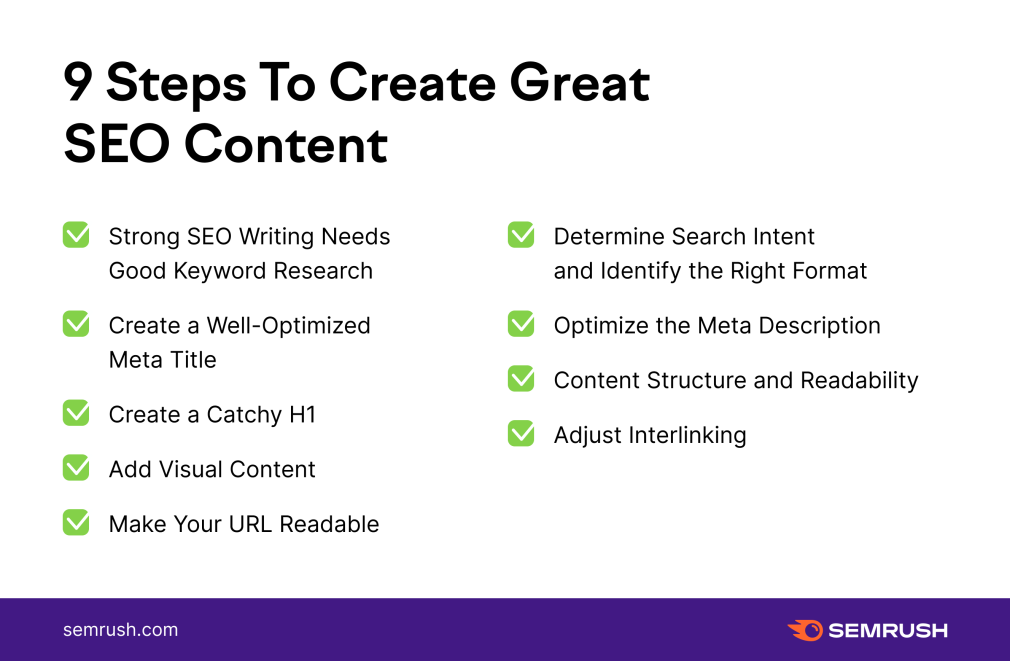
The Google search engine crawls on every web page on the internet, curates it based on set parameters (algorithms), and displays the best pages as answers to its users.
The search result pages will have both organic and paid content. But, SEO content writing only focuses on organic search result pages. According to studies, the organic search pages appear more credible to the searchers and receive more clicks than paid advertisements.
Below are the key Google Webmaster Guidelines to write SEO content:
- Focus on creating content for your target audience. Everyone on the internet reads not every piece of content. People use Google with a purpose, to get answers to their queries.
- Keep it simple. It is often seen that users land on the page and do not find the right content.
- Make your content unique.
- Think about why someone will read your content from the millions of pages listed on Google.
- Make your content authentic.
- Make your content credible.
- Create a brand.
- Do not create content using bots. Google is much more intelligent than you are.
- Avoid plagiarism.
- Do not use link schemes or hide any text/links.
- Always provide in-depth and engaging content to your users.
- Provide title and headings.
- Build internal links on your website.
- Focus on improving your page speed.
- Avoid duplicate content.
- Avoid keyword stuffing.
- Avoid cloaking or showing the search engine different content than your searchers.

2. Understand how search engines work
From Step 1, we learned that search engines are nothing but answering machines helping users discover stuff on the internet by showing the right set of answers. So, how to write SEO content? And, how do you list your web pages on Google?
There is a set process by Google and every search engine that allows you to inform the answering machine that you have created a new website or web page.
Here’s how it works:
- Install and run sitemap and Robots.txt on your website. This will allow search engines to crawl your website and look for content or URL which has a good readability and follows the defined standards.
- Once the search engines are done crawling, they will start analyzing and indexing your content. Once a user searches for something that matches your web page’s keywords, the web page is listed on SERPs.
- Now, depending on the number of queries the web page has answered, user experience, and how frequently the user is looking into the content, Google determines the website’s rank.

Below are some of the reasons your webpage might not get displayed on search engines:
- The website has followed Red Hat techniques to get listed.
- The website code is not optimized, or it is not allowing the crawlers to analyze the content. It’s time to review your website code.
- The website does not have quality backlinks.
- The website is relatively new and hasn’t been crawled by search engines.
- The website navigation is not aligned with industry standards, making it difficult for robot crawlers to list.
Best practices for website navigation:
- Do not have separate navigation for desktop and mobile view.
- Never have a personalized view for your users on the home page. This will be considered cloaking by Google.
- Link all your navigation pages on your website homepage.
3. The power of keyword research
From getting your SEO content writing basics right to understanding how search engines work, let us now understand how keywords will determine your website’s success.
Before getting into keyword research, it is essential to understand your target audience, goals, the services or products you will be offering, and the type of content you will be writing on your website.

So, why are keywords so important?
Keywords are nothing but the search terms people are looking for on Google. Keywords will help you reach out to your target audience, bring them to your website, and take action (subscribe, buy, register, etc.).
How to start with keyword research for SEO-friendly content?
- Start by looking into standard search terms people search online for your business.
- Use the below keyword research and planning tools:
- Google Keyword Planner: One of the best tools in the market for keyword analysis and research. It helps understand how many queries a search engine receives for a particular keyword and how much the search volume is.
- Google Trends: If your website focuses on showing the current trends, this is a mandatory tool. For Example, ‘Holi skincare tips’ will be trending during the Holi festival in India.
- AnswerThePublic (ATP): This tool helps list the popular questions for a specific keyword, which helps in the keyword planning of your website.
- SpyFu: This is a paid tool to get more competitor data and keywords.

How many types of content do people search online?
- Informational queries: Search related to seeking information like a person or place.
- Navigational queries: Search related to seeking navigation on the internet like Dailyhunt.
- Transactional queries: Search related to seeking information like hotels, music preference, etc.
- Commercial queries: Search related to online purchase.
- Local queries: Search related to local shops or Google Maps.
4. Getting your on-page SEO right
Now that we’ve understood the target audience and keyword research, it’s time to optimize the web page to answer the user’s query.
On-page Optimization or SEO content writing is nothing but combining all your content and research into consumable online content.
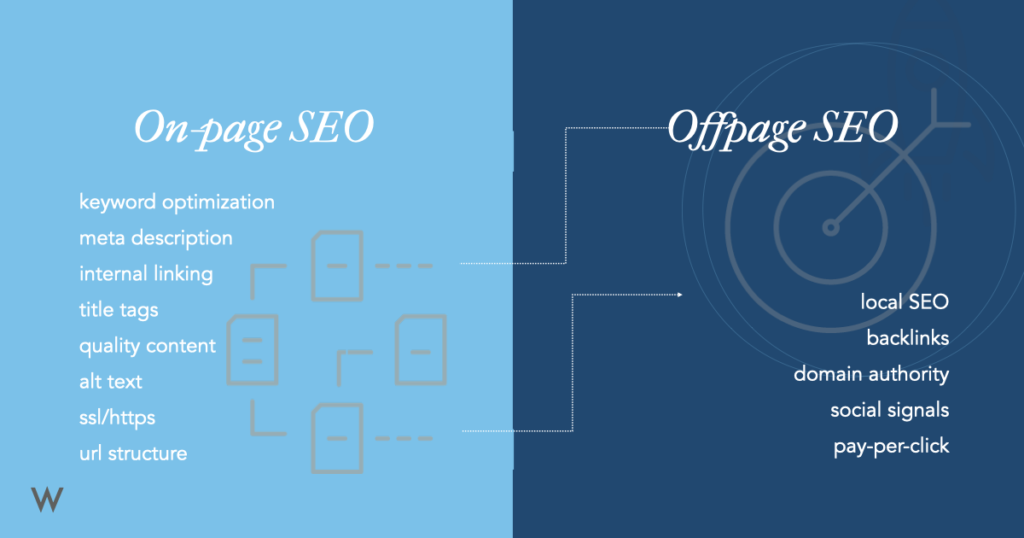
Apart from writing SEO content we mentioned in Step 1, below are the techniques of on-page optimizations your webpage needs:
- Optimize your Header Tags: The HTML element includes the H1 tag and sub-heading from H2 to H6 tags.
- As we mentioned earlier, search engine robots crawl on your website and look for content. Hence, the internal linking structure of a website is an important on-page optimization method that is required to establish your site on the web.
- Avoid hiding links or texts on your website: While internal linking your site, do not put your navigation links as drop-down because search engine robots do not crawl through drop-downs.
- Use Anchor text to link your web pages: It allows search engines to read the content of your destination pages.
- Avoid linking huge volumes of links on a webpage. Depending on the size of your blog or website, link a few mentions Google Webmaster Guidelines.
- Ensure you have a secure website with Secure Socket Layers (SSL) certificate when writing SEO-friendly content. Google robots consider this as an essential on-page optimization factor.
- Always ensure that you redirect your removed or renamed pages to a valuable new web page. As per Google, it should not be more than 3 to 5.
- Optimize the images on the website: Always consider optimizing the images before you upload them to the website.
- Add Alt Text (Alternative Text) to all your images: This allows website crawlers to understand what the picture is all about and index it.
- Consider submitting the image sitemap in your Google Search Console account.
- Add meta-description and title tags to your web page.
5. Getting your technical SEO right
The technical structure of your web content is the defining factor of your website’s performance. Hence, we must understand how it works. Consider the following:
- If your website’s loading speed is not good or loads slower than usual, Google will never rank it since it is considered a bad user experience.
- When users type a domain name on their browser, they request the domain by clicking on the URL. The browser makes a request and looks for a DNS lookup request. The server sends the required resources to display the website on the user’s browser.
- The HTML of a website indicates what a website says (title, body, etc.)
- The CSS of a website indicates the color, fonts, etc.
- The JS (JavaScript) of the website indicates its behavior and interactiveness.
- Ensure that your website is optimized for mobile users, as mentioned in Google Guidelines for mobile optimization.
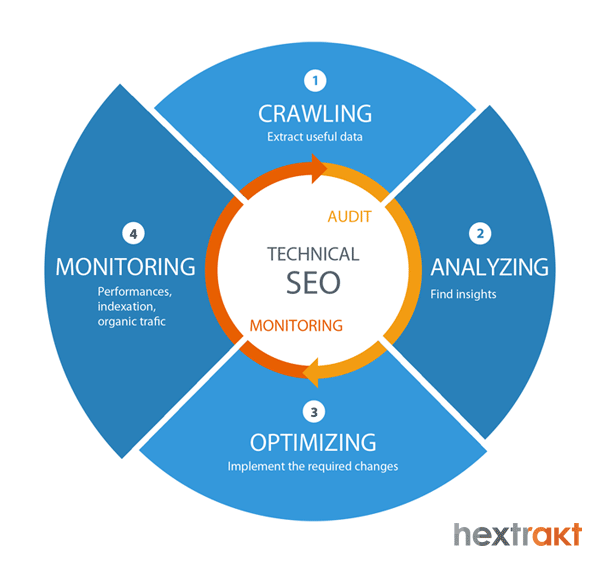
6. Building backlinks and website authority
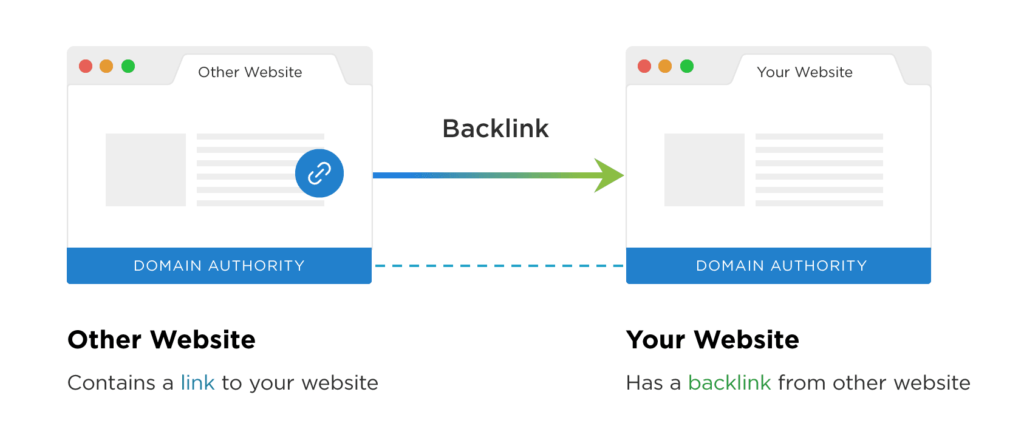
As per Google, backlinks and website content quality are the most critical factors in writing SEO content and ranking it on search engines.
Quality backlinks send qualified traffic to your website. As mentioned earlier, Anchor text should be descriptive, which helps Google identify your page topic. The backlinks should be relevant to your website and from similar authority websites. According to Google User Content, it is also equally important to evaluate the quality of the backlink website.
Below are SEO content writing tips on what to avoid while backlinking:
- Linking spammy websites or links.
- Do not purchase a link.
- Avoid link exchanges.
- Avoid links from low-quality websites.
7. How to ensure you’re on the right track?
While we all want our website to be on top of search engines, it is crucial to track the progress of SEO on the website. Always have measurable and trackable goals set for your website.
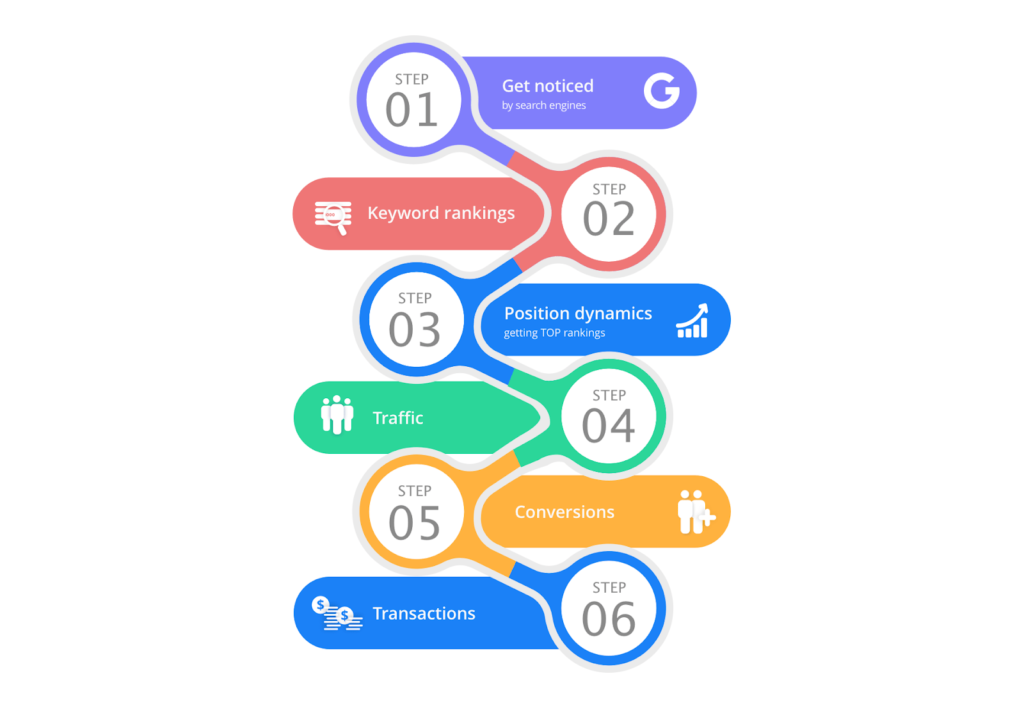
Below are a few engagement metrics you can track to ensure that your SEO content writing is working or not:
- Conversion rate: It can be a newsletter subscription or sales on your website, or the number of unique visits. The conversion rate helps you in calculating your ROI.
- Time spent by users on your webpage: While you spend hours and days developing and writing SEO-friendly content, what if the user spends only 3 to 5 seconds on your webpage? This indicates that your content was not adequately planned or needs revision. This also points to Google that your page probably has a bad user experience, and thus, Google will avoid ranking your pages.
- The number of pages per visit: While users spend time on your website, it is equally important to keep them engaged. The pages per visit metrics help you track how much the users are engaged on your website.
- The bounce rate of your webpage: We all get some junk traffic, no matter how much we try to keep it at bay. Keep the bounce rate as low as possible. If the bounce rate is high, it indicates that your content or website is not targeted to the right audience.
- Domain Authority and Page Authority: Keep track of your DA and PA while working on your website’s progress.
- Track Keyword Ranking: Keep a check on the SERPs on your keyword’s progress. Have long-tail keywords in your blogs that help rank your website.
Now that we know everything about writing SEO content, it is essential to follow the guidelines mentioned above to make SEO content writing a habit.

Key Takeaways
- SEO content writing is of utmost importance to rank on search engines. A business must prioritize making themselves more visible as it helps news users find their products or services.
- To write SEO content, one must include an adequate number of popular search phrases, aka keywords, in their content. It helps search engines to understand that your website has the content a user is looking for.
- First and foremost, writing SEO content is the process of optimizing your website. Along with making content more shareable, you must also focus on enhancing the content loading speed of your page.
- Another vital SEO content writing tip is to include keywords in the meta title, meta description, page titles, sub-headings, URLs, etc.
- If you want to master SEO content writing, focus on localized searches. Most users search their necessities with searches like ‘near me.’
Conclusion
Search engine optimization (SEO) is optimizing a website so that users can easily come across it. Ensure that you measure success metrics like website conversions, bounce rates, and blog subscriptions. The only way to rank on search engines is to write meaningful SEO content. The most important SEO content writing tips ensure content relevance and website crawlability.
FAQs
Here are a few steps to write SEO-friendly content:
– Audience-first writing approach
– Stick to your niche. Put punchy headlines
– Incorporate keywords any chance you get
– Structure your writings
– Include images/GIFs/YT videos/links
– Promote across social media
Writing SEO content includes implementing keywords and key phrases into your website content. It aims to make your website more search-engine friendly. However, your content must be meaningful and relevant to your target audience to rank on search engines. Avoid keyword stuffing.
Follow these three steps to write the best SEO content:
– Target keyword phrases
– Avoid stuffing keywords or over-optimization
– Put keywords in your headline.
Some SEO content writing tips are as follows,
– Include headlines and subheadings
– Add links to previous content
– Optimize the length of your article
– Choose your keywords wisely
– Optimize your images
– Make the content shareable
– Write well-researched content
– Use content optimization tools.
To write SEO content, follow these steps,
– Study and practice SEO
– Build a portfolio
– Experiment with your content
– Master researching quality content & references
– Leverage social media.
Some off-page techniques to writing SEO content are as follows,
– Create backlinks
– Effective social media marketing
– Guest posting
– Online discussions
– Local directory listing
Latest Blogs
Explore how Google’s 2025 AI search updates triggered ranking chaos. Learn actionable strategies to adapt your SEO for AI Overviews, zero-click searches, and SERP volatility. Stay ahead now.
Learn how to rank on AI search engines like ChatGPT, Perplexity, and Gemini by optimizing your content for authority, structure, and relevance. Stay ahead in AI-driven search with this strategic guide.
Explore the best healthcare SEO services for your medical practice. Improve online visibility and effectively reach more patients in need of your services.
Get your hands on the latest news!
Similar Posts

B2C Marketing
5 mins read
Top Choices for Best Content Marketing Services in B2B Industries

Artificial Intelligence
5 mins read
How A Lead Generation Specialist Can Use AI-Powered Content Funnels to Drive Conversions

Artificial Intelligence
4 mins read